|

An Exciting Time in the Online Space
Every month, CLICK provides ECPs and optical retailers with the tools they need to build their presence online and grow connections with
their patients. The latest in a series of popular e-newsletters from Vision Monday, CLICK is a monthly briefing designed specifically to
provide practice insights and ideas about the latest Web site features, tools and Web-based applications.
Miss something? Check out the complete 2009 archives of CLICK at
www.visionmonday.com. Tried something new on your Web site?
Tell us about it and we'll consider it for an upcoming feature in CLICK.
—The Editors

Pew Internet & American Life Project: 61% of Americans Look Online for Health Information
WASHINGTON D.C.—At the start of this new year, it’s a good time to fully embrace the change that the Internet and technology have created in
our lives and in patients’ lives—and assess what it means to the daily eyecare practice and eyewear dispensary.
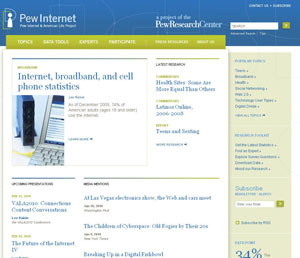 The Pew Internet & American Life Project is one of seven projects that make up the
Pew Research Center, a nonpartisan, nonprofit “fact tank” that provides information on the issues, attitudes and trends shaping America and the world.
The Project produces reports “exploring the impact of the Internet on families, communities, work and home, daily life, education, health care, and
civic and political life,” according to the resource-rich Web site.
The Pew Internet & American Life Project is one of seven projects that make up the
Pew Research Center, a nonpartisan, nonprofit “fact tank” that provides information on the issues, attitudes and trends shaping America and the world.
The Project produces reports “exploring the impact of the Internet on families, communities, work and home, daily life, education, health care, and
civic and political life,” according to the resource-rich Web site.
Here are some recent Pew Internet insights to ponder:
A majority of American adults look online for health information and most are accessing reviews and comments posted by fellow consumers. According to
a
June report released by the
Pew Research Center’s Internet & American Life Project and the California HealthCare Foundation, 61 percent of adults look online for health
information. Of those, 59 percent have done at least one of the following activities:
- Read someone else's commentary or experience about health or medical issues on an online news group, website, or blog
- Consulted rankings or reviews online of doctors or other providers
- Consulted rankings or reviews online of hospitals or other medical facilities
- Signed up to receive updates about health or medical issues
- Listened to a podcast about health or medical issues
In addition, 20% of internet users who have looked online for health information, or “e-patients,” have actively contributed comments,
reviews, and updates. E-patients in this group have, for example:
- Tagged or categorized online content about health or medical issues
- Posted comments, queries, or information about health or medical matters in an online discussion, listserv, or other online group forum
- Posted comments about health on a blog
- Posted a review online of a doctor
- Posted a review online of a hospital
- Shared photos, videos or audio files online about health or medical issues
In sum, 60 percent of e-patients (37 percent of all adults) have done at least one of the above activities.
“We are beginning to see e-patients turning to interactive features both to help them find information tailored to their needs and to post
their own contributions,” says Susannah Fox, a co-author of the report, and associate director of the Pew Research Center’s Internet & American
Life Project. “They treat the Internet as a supplement to traditional sources of information, using blogs, podcasts, and other online resources
to deepen their understanding of a condition and sharpen their questions for a health professional.”
In the Pew Internet/California HealthCare Foundation report,
“The Social Life of Health
Information,” is a description of how the e-landscape has shifted in the last decade. In 2000, 46 percent of American adults had access to
the Internet, 5 percent of U.S. households had broadband connections, and 25 percent of American adults looked online for health information. Now,
75 percent of American adults go online, 57 percent of American households have broadband connections, and 61 percent of adults look online for
health information.
An April 2009 survey
shows that 56 percent of adult Americans have accessed the Internet by wireless means, such as using a laptop, mobile device, game console, or MP3
player. The most prevalent way people get online using a wireless network is with a laptop computer; 39 percent of adults have done this.
The report also finds rising levels of Americans using the Internet on a mobile handset. One-third of Americans (32 percent) have used a cell phone
or Smartphone to access the Internet for emailing, instant-messaging, or information-seeking. This level of mobile
Internet is up by one-third since
December 2007, when 24 percent of Americans had ever used the Internet on a mobile device. On the typical day, nearly one-fifth (19 percent) of
Americans use the Internet on a mobile device, up substantially from the 11 percent level recorded in December 2007. That’s a growth of 73 percent in
the 16 month interval between surveys.

Baystone: Offers ECPs Customized Sites, Multi-Media Enhancements
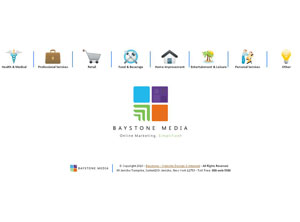 JERICHO, N.Y.—
A new resource for eyecare professionals looking to update their online presence is a company which has specialized in helping professionals in the
dental, cardiology and OB/GYN fields, among others, to develop theirs. JERICHO, N.Y.—
A new resource for eyecare professionals looking to update their online presence is a company which has specialized in helping professionals in the
dental, cardiology and OB/GYN fields, among others, to develop theirs.
Baystone Media is a full-service web design company which is now targeting eyecare professionals with customized Web site
services involving no initial set-up fees or long-term contracts, but monthly fees for unlimited pages plus various optional packages of content
development, video enhancements and search engine optimization.
States Kara Hirsch, marketing manager, “We bring experience in many different industries, from architecture and food and apparel
retail, including development for medical specialists. We think we offer a lot to eyecare practitioners and eyewear retailers who are looking build
modern, new sites in an easy way, with dedicated customer service and simple-to-use management systems.”
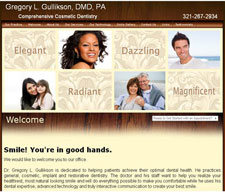 Hirsch explained Baystone’s work
now brings to the optical market “the basic building blocks of the site” along with choices of ‘gold’ and ‘silver’ packages or suites of
site enhancements. Hirsch explained Baystone’s work
now brings to the optical market “the basic building blocks of the site” along with choices of ‘gold’ and ‘silver’ packages or suites of
site enhancements.
Baystone’s content is written by professionals and is then customized by each doctor or professional for the needs of their eyecare practice,
optical boutique or dispensary. Options include e-commerce capabilities, e-newsletters, search-engine-optimization (SEO) and a range of
direct-to-patient communication tools. “From e-newsletters to reminder cards to special notices, these tools help build and develop patient
loyalty and also help build referrals for practices,” Hirsch notes.
She also points out that the company’s customer service and telephone consultations will provide step-by-step advice about the style, look and
content of high-performance sites. In addition, the customizable nature of the site-building, allows for simple and continual updates. “We offer
unlimited customer support, and don’t charge to make changes. We offer constant support, although the sites’ content is relatively simple to preview
and manage.”
Some of Baystone’s media enhancements include ‘live’ video spokesmodel spots, social media connections to maximize the power of the sites,
and other features.


|

Shorten Links to Twitter
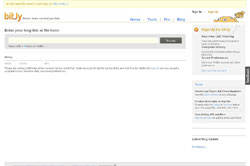
The award-winning bit.ly allows users to shorten, share, and track links (URLs). Reducing the URL length makes sharing posts
easier. bit.ly can be accessed through the company’s Web site and bookmarklets. bit.ly is also integrated into several popular third-party
tools such as
Tweetdeck. A more
complete list of third party tools can be found at
www.bit.ly.

Looking for Royalty-Free Images?
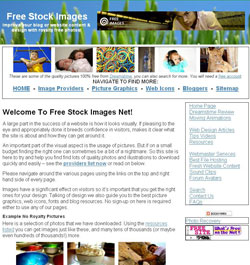
Quality images are essential for any good Web site, but locating royalty-free images is easier via this site, which lists a range of visuals
and resources for site enhancement. A directory to a range of images, along with tools and advisories about how to use and download them, is
part of the aggregated info at this location.

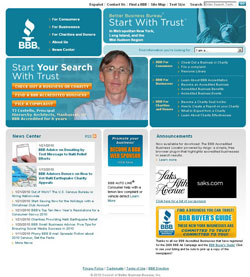
Better Business Bureau
For businesses, charities, professionals and consumers, the resources of the
Better Business Bureau (BBB)
are more accessible than ever via the Web. Do you have a good reputation in your local market? Are there any concerns you should be aware of?
Think you’d benefit from connections with other businesses in your market? Local BBB site can provide a range of resources and reference
tools—as well as tools for your team to use to update the city or state BBB about your own business and its role in the community.

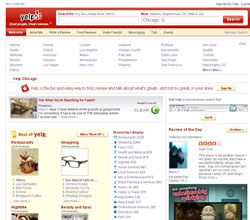
YELP.com
The power of the referral or recommendation is amplified in today’s media world via social media networks and user groups/Web sites
like
YELP.com. Yelp is the easy way to find, review and talk about what's great—and not so great—in a local area. And millions of consumers are signing up to become members in order to rank, rate and explain what they think of thousands of local and neighborhood services from eyecare practices and optical retailers to restaurants, shops and hotels. What are they saying about you?
|